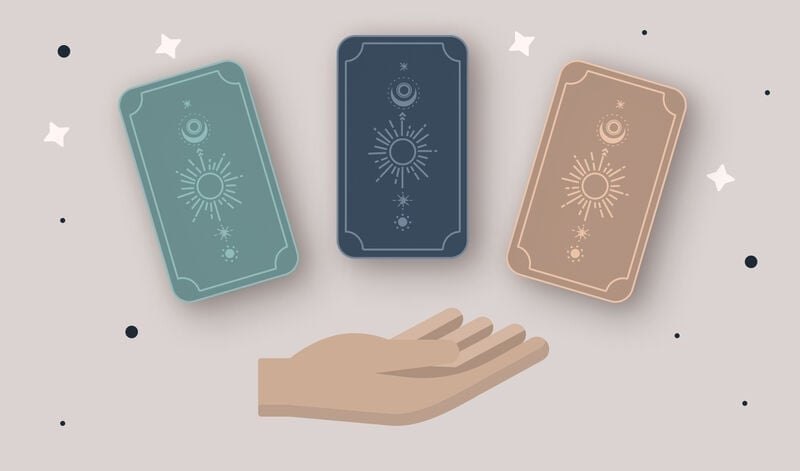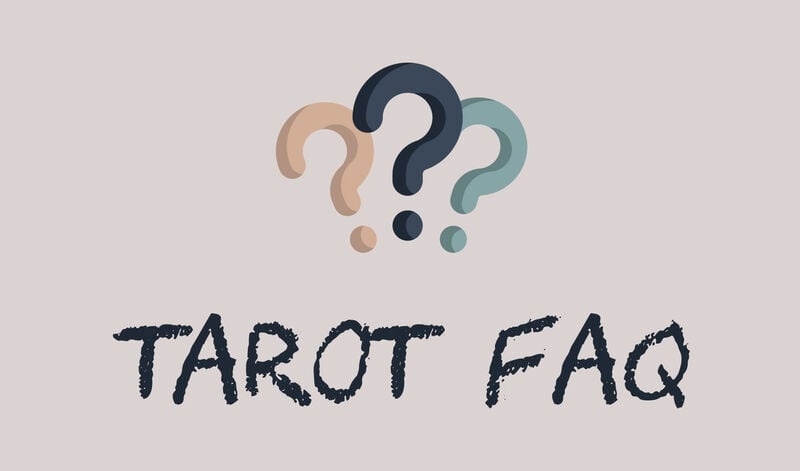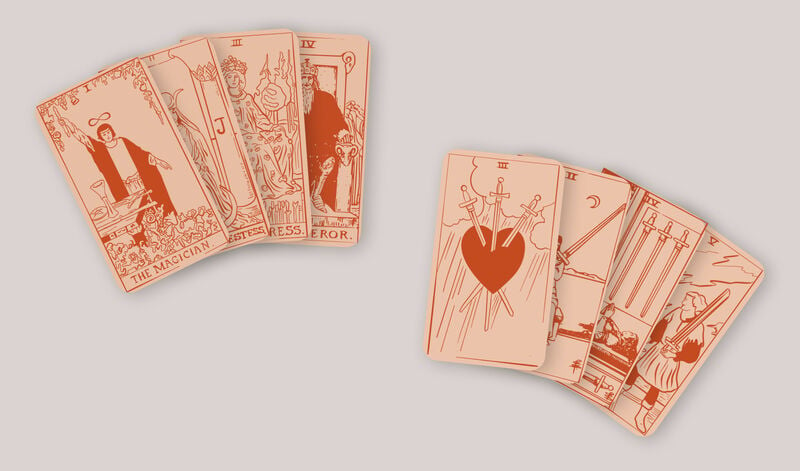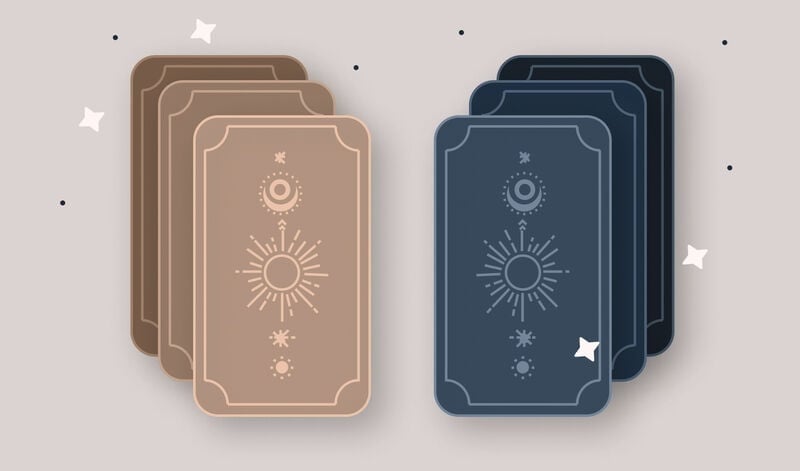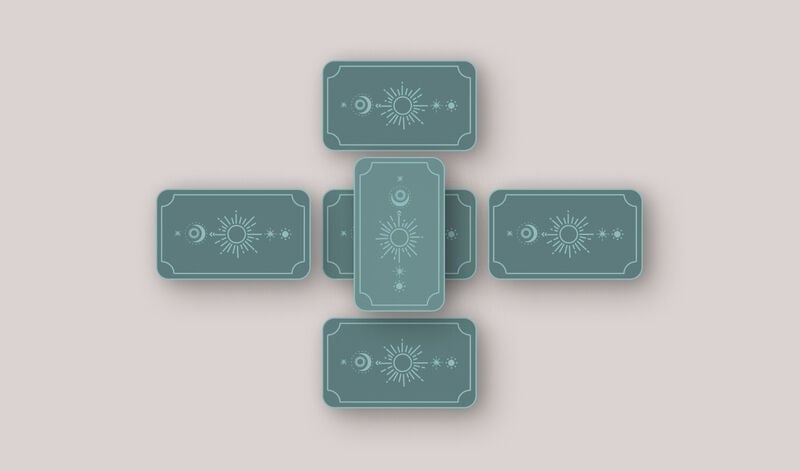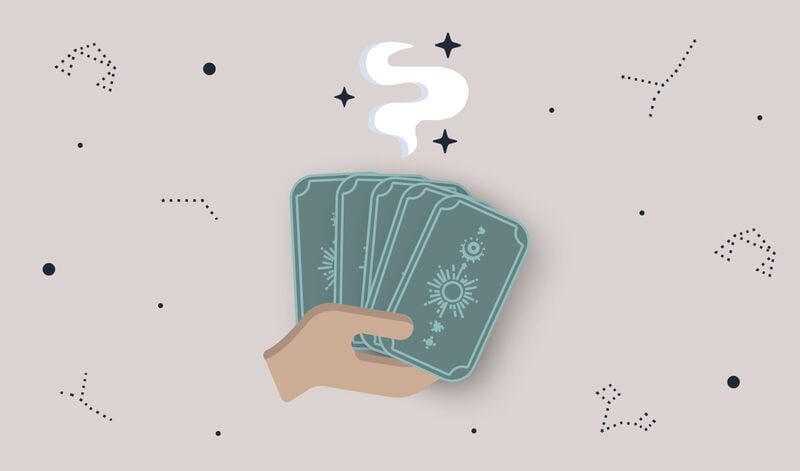Every tarot reader will have their preferred spreads and way of working with the cards. Much of this work happens intuitively, and this skill is something that can be developed over time with practice and as you gain a growing awareness of yourself as a tarot reader.
A tarot spread is a specific way of laying out the cards to answer a question or provide insight, focus, or a point of meditation for the querent. There are many different spreads; now is your chance to familiarize yourself with some of the most enduringly popular ones below.
Before beginning to lay out the cards, the reader will ask the querent to shuffle the entire deck in most cases. Whether or not you want to use reversed card meanings in your spread may determine how you ask the querent to mix the cards. Usually, while they’re shuffling the cards, the reader will ask the querent to concentrate on the question or circumstances they wish to receive an answer for or guidance on, or on a focused intention.
Once the cards have been shuffled, the querent will usually hand the deck back to the reader, ready to lay out the chosen spread.
Best Beginner’s Level Tarot Spreads
As you learn to work with the cards, drawing just a small number for a spread is often a good idea to help you gain confidence and learn the meanings and nuances of your deck. As your knowledge builds and you become more comfortable with reading intuitively, you may wish to progress to more complex spreads that incorporate more cards.
One Card Spread
The One Card Spread is a simple but effective way to get used to working with the cards and is also a great way to build a daily reading into your routine, as the whole process takes just a few minutes and so can be easily scheduled into your day. Follow these steps for a one-card spread:
- Hold the deck in your hands and gently tap the cards a few times; many readers do this to spread their energy throughout the deck.
- Shuffle the cards while keeping a question firmly in your mind - put all your energy into it. Try to make this a query that doesn’t require a simple ‘yes’ or ‘no’ answer. You could ask, for example, ‘how can I gain more confidence at work?’
- When you instinctively feel that you have mixed the deck enough, spread out the cards and select the one you feel most drawn to. As part of the mixing process, it’s not unusual for one or more cards to jump from the deck; if you feel it’s right, stop at this point and choose one of the cards that are clamoring for attention.
- The card you have chosen will provide the answers or guidance you seek. Consult a guidebook, use your intuition, or a mix of both approaches, to understand its special message for you.
Three Card Spreads
Three card tarot spreads are popular with beginner readers and those with plenty of experience. They allow for more in-depth reading and can be adapted to various types of queries. The most popular three-card spreads can be found below:
Past, Present, Future Tarot
Past, present, and future is a classic tarot spread. The first card indicates the past and how it impacts the current situation, the second represents the present, and the third represents the future.
For example, a querent may ask how they can best go about mending a difficult relationship with a family member. Suppose the first card pulled is The Emperor. In that case, it could indicate that perhaps there has been a domineering element to this relationship in the past, or there have been barriers erected that have prevented you (or them) from getting close. It is these things that are still having an impact on how you deal with this person now. In the present position, the Fool could indicate that you are ready for a new start with this person and that now is the perfect time for this. The Ten of Cups suggests that the result will be a happy one and that you will be able to not only reforge your connection with this person but that this will bring great joy to both of your lives.
If the future card doesn’t represent the most desirable outcome, don’t worry. By following the advice inherent in the spread, the querent will most likely be able to avoid this eventuality coming to pass.
Mind, Body, Spirit Tarot
The mind, body, spirit three-card spread is best used to get a general sense of a situation or to help the querent raise their own awareness, rather than as a way to get an answer or guidance on a specific question. It’s a good spread for the reader to understand how the querent's life lacks balance and how it can be addressed.
The three cards, relating to, consecutively, the mind, body, and spirit, indicate how balance can be restored in each of the three planes.
Situation, Obstacle, Advice Tarot
In the situation, obstacle, advice three-card spread, the first card indicates the circumstances at hand; often, it points to how the querent's actions influence the situation. When the second card is pulled, it is placed across the first card: it shows what factors are at play in causing the difficulties inherent in the querent's current circumstances. The third card is the advice given; how can they act or what can they do to resolve the situation or make the best of it.
Five Card Spreads
Five-card spreads offer the reader the opportunity to obtain more insight into the reasons behind the situation or question at hand and are a great way to continue to build your skills and intuition.
Cross Formation Spread
This spread is a more developed version of one of the earlier three-card spreads. Layout three cards, as in the Past, Present, Future spread, and then add a fourth card placed above the Present card and a fifth below the Present card to form the cross of its name.
In the Cross Formation spread, the fourth card indicates the key underlying reason or reasons behind the situation, while the fifth symbolizes the potential outcome; this is not, however, the definite result, but simply the possibilities as they currently stand.
Rectangle Formation Spread
Some spreads, like this one, can enable the reader to help the querent identify overarching patterns in their life or the set of circumstances that they find themselves in. Seeing these repeating influences can often be fundamental to doing things differently.
For this tarot spread, the reader places four cards in a rectangle formation, starting top left, then placing a card top right, followed by the bottom left and bottom right. The final card is drawn and placed in the middle of the rectangle.
Each card represents, consecutively, the present situation, influences, challenges, final outcome, and the overarching theme or pattern inherent in the situation or the querent's general way of life. Some readers prefer to place more focus on the meanings of the four surrounding cards to best suit the reading itself; for example, the Influences card could represent a specific person’s impact on the circumstances, and the Final Outcome may represent how the querent can use their skills to achieve the outcome they desire.
Using the Cards to Ask a Specific Question
Sometimes, the querent (whether that’s yourself or someone for whom you are reading) may wish to ask a focused question, rather than wanting guidance on a general situation or for a point on which to meditate for greater self-awareness. These types of spreads can initially feel a more tricky proposition: the cards must be interpreted to relate specifically to this set question. But, with practice, readers can become skilled in this. A great place to start is the simple Yes or No reading; once you’ve gained more confidence with and experience in using the cards, you then may wish to move on to the Celtic Cross Spread for a more in-depth look at the question in hand. Both are detailed below.
Yes or No Tarot
This simple one-card reading allows the querent to concentrate on a particular question and pull a single card for an answer. Readers will need to familiarize themselves with which cards indicate ‘yes,’ which point to ‘no,’ and the cards that mean ‘maybe.’
A Yes or No reading doesn’t allow for an in-depth look at a situation but can be a great way to practice working with the cards and can be helpful when an extremely focused response is required. Sometimes, a Yes or No reading can then lead to a reading utilizing more cards, and, in this way, it is a useful starting point to identify the fundaments of the issue.
The Celtic Cross Spread
For those who have some experience and are confident and comfortable using the cards, the Celtic Cross spread is a great choice that allows for the full nuances of each card to be developed as it relates to a query.
This spread begins with a small two-card cross. The reader places the first card chosen, representing either the querent’s role or a general theme. The second card is placed across the first and symbolizes a critical challenge that the querent is facing regarding the question they are seeking guidance on.
The third card is laid down beneath this cross; this card offers a message about how the past, often the long past, influences the querent. The fourth card is placed to the left of the small cross and points to an event in the querent’s recent past that is having an impact on the present situation.
Next, the reader can lay down the fifth card above the small cross and represents a potential outcome; note, this isn’t a definite outcome, but the way in which things are tending at the moment. The sixth card is placed to the right of the cross and points to something that will happen in the near future that will influence the events or situation that the querent is asking about.
The final four cards are laid out in a vertical line to the right of the cards that have already been placed, starting from the bottom and working upward. In this way, the seventh card indicates the querent’s previous experiences, habits, or usual practices that may be affecting the situation. Card eight relates to how the querent’s environment is feeding into the issue, and this can include the people that may be surrounding the querent. The ninth card symbolizes the querent's hopes and fears, while the tenth card points to the likely outcome.
This spread will need some practice to master, and teasing out all of its intricacies and nuances can often take some time. Use your intuition, and have patience with both yourself and your deck as you familiarize yourself with this way of laying out the cards.
Love Spreads
Love tarot spreads are perennially popular and can be used to answer questions concerning relationships and love in all its forms, whether that’s relating to a long-term marriage, a new connection, or a friendship.
Three Card Love Spread
This focused spread is perfect for beginner readers and is useful for those with more experience, too. Three cards should be pulled from the deck to represent, respectively, the querent, the other person in the relationship, and the relationship itself.
Five Card Love Spread
For this more in-depth love spread, the first card laid is the central card representing the theme of the question or the situation as it currently stands between the querent and their specific person. The reader then places the second card to the left of the central card, which symbolizes the issue from the querent’s point of view, while the third card, laid to the right of the center card, is the other person’s perspective.
The fourth card should be placed below the center card and can indicate something in the past that is affecting events or the foundation of the situation. Finally, the fifth card is laid above the center card and signifies the likely final outcome.
Love Relationship Spread - Ten Cards
This spread allows for a deep look at the foundations of a relationship, issues present within it, and its potential.
To begin, the reader should place five cards in a horizontal line. The first card tells of how events in the distant past affect the current situation. The second represents the influence of the recent past, and the third shows the state of the relationship in the here and now. The fourth card in the line indicates future influences, and the fifth symbolizes the effects of environmental influences, such as family or financial affairs.
The next five cards delve deeper into overarching themes within the relationship. The sixth card represents the querent’s own views about the relationship and is laid above the line of five. A seventh card is placed below the line and points to the good energy at play in the relationship. An eighth card is placed next to the seventh and represents energies that could be working to the detriment of the relationship.
The ninth and tenth cards are laid above the sixth card and indicate, respectively, the querent’s hopes and fears regarding the relationship and the likely outcome.
Tarot Spreads to Promote Mental Health
This five-card spread can help a querent understand their own psychological processes and how they are applied to the world around them, including the people they encounter on their journey.
The first card is laid, and then the next three cards are placed in a line above it so that the third card is placed above the first - this card is the center card. The fifth and final card is placed above the center card.
The first card asks the querent to think about the things they see in other people that they don’t see in themselves. The second asks the reason for this, and the third asks how this projection can be reclaimed by the querent. The fourth card directs the querent to consider how they’ll feel when they release this pattern of thought, and the fifth asks how this change will bring benefit to their lives.
Experienced Tarot Spread Readers
The spreads below are perfect for readers who have developed confidence working with the cards and allow for a reader’s intuition and experience to fuse to achieve a deep and intricate reading.
The 7 Card Horseshoe Spread
This spread is helpful when a decision is required, or the querent isn’t sure which course of action to pursue. The seven cards in this spread should be laid out in a horseshoe formation, with the fourth card in the middle of the shape.
A popular way to assign meanings to each of the cards is to have the first card representing past influences, the second issues in the present, the third as how things will unfold in the future, and the fourth card, offering advice to the querent. The fifth card can indicate how other people’s influence could affect the querent’s decision, the sixth as hidden influences or obstacles that could crop up, and the seventh as the best course of action that the querent can take in relation to the question.
The 12 Card Astrological Spread
For this spread, lay twelve cards out, one for each sign of the zodiac, in a clockwise circular formation. There are a number of options in terms of assigning meanings to each card. You could reach each one as embodying an element of the zodiac sign it represents, as detailed below, or, if the reading is undertaken at the start of a zodiac cycle, then each card could stand for the twelve cycles of the year.
Card one (Aries) asks the querent how they express and define themselves, and the second card in the spread (Taurus) is for reflection on what guides the querent’s hopes and dreams. Card three (Gemini) asks the querent to think about how their decisions are influenced by the things they love, card four (Cancer) is regarding how the querent strives for their goals while keeping themselves safe and focused, and card five (Leo) is concerned with how the querent copes with conflict.
The sixth card in the spread (Virgo) asks the querent to consider how they access their higher selves and balance their emotions; card seven (Libra) points to how the querent can promote fairness in their dealings with both themselves and those around them. The eighth card (Scorpio) bears a message about the thing or things in the querent’s life that no longer serve them and should be released.
The ninth card (Sagittarius) represents the areas of the querent’s life that require balancing, the tenth card (Capricorn) symbolizes temptations and distractions that the querent may best avoid in their journey towards self-growth, and the eleventh card (Aquarius) asks the querent to identify the true desire of their heart. Finally, the twelfth card (Pisces) represents the querent’s shadow self and what elements of this (positive or negative) need to be gently pulled into the light.
Navigating Your Tarot Journey
Enjoy exploring the spreads above and discovering those that most resonate with you. Keeping a journal that details the spreads you have completed, your thoughts about the readings, and specific cards or card combinations that arise can be a really helpful way of navigating your tarot journey.
